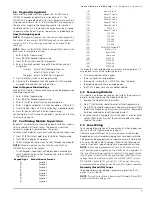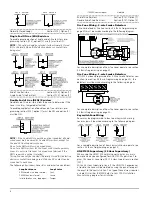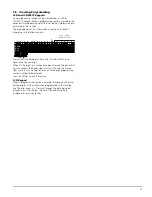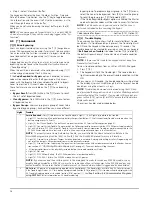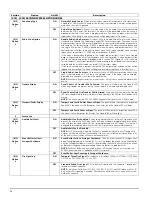
20
5.1 For the Record
This Section identifies the Client, Installation Date, Installers
Code, Hardware configuration and Programming summary for
each zone. Remove these pages and retain for reference.
5.2 Keypad Programming
Refer to Section 2.6 ‘Keypad Assignment’
5.3 Basic Programming
[001]-[004] - Zone Definitions
These sections require 16 two digit entries. Each two digit num-
ber entered determines how a zone will operate.
NOTE:
In addition to selecting how each zone will operate,
attributes may be programmed by zone (See Section 5.4 Advanced
Programming PWS Sect 4 [101-[164]).
[001]-[004] ZONE DEFINITIONS
Option
Zone Type
Description
00
Null Zone
For zones that are not used and do not require a closed loop or EOL resistor
01
Delay 1
Follows the Entry Delay 1 and Exit Delay programmed in Section [005] and is normally used for Entry/Exit doors.
The exit delay starts as soon as the panel is armed. The zone may be opened and closed during the delay time
without causing an alarm. After the exit delay time has expired, opening the zone will start the Entry Delay
timer. During the Entry Delay time, the keypad buzzer will sound steadily to advise the user that the system
should be disarmed. If the panel is disarmed before the Entry Delay expires, no alarm will be generated.
02
Delay 2
Operates the same as Type [01] zone except the Entry Delay time can be independently set in Section [005].
The Exit Delay time is common to both zone types.
03
Instant
Normally used for door and window contacts and has the standard Exit Delay, but is instant when opened
after the Exit Delay expires
04
Interior
Used with interior motion detectors. Interior zones feature an Exit Delay and an Entry Delay provided that any
Delay type zone has been tripped first. If the protected area is entered without coming through the a delayed
entrance and an Interior zone is tripped, an immediate alarm will be generated
05
Interior Stay/Away.
If the system is armed and a Delay zone is NOT tripped during the exit delay time, this zone type will be
bypassed. If the [*][1] command is used to activate all Stay/Away type zones, this zone will have the standard
exit delay. Once armed, this zone will act like an Interior type zone [04].
06
Delay Stay/Away
If the system is armed and a Delay zone is NOT tripped during the exit delay time, this zone type will be
bypassed. If the [*][1] command is used to activate all Stay/Away type zones, this zone will have the standard
exit delay. Once armed, this zone will follow the Entry Delay time for Entry Delay 1 when tripped.
NOTE:
The automatic bypass on Stay/Away type zones will not be removed by any event other than a valid
exit through a non-Global Delay type 1 zone during the exit delay or by pressing [*][1] while armed.
07
Delayed 24 Hour Fire
(Hardwired)
Operates the same as the standard Fire zone, except the alarm memory and transmission by the communica-
tor is delayed by 30 seconds. If the alarm is acknowledged by pressing any key within 30 seconds, the bells
will silence and the transmission will be aborted. If the alarm has been acknowledged, and the smoke detec-
tor has not been restored to normal, the bell output will activate after 90 seconds, the user then has another
30 second delay before the bell output latches and communications is activated. A code is then required to
silence the bell output.
NOTE:
The Fire Delay will be terminated if a 2nd Fire zone is tripped or if the [F] key is pressed during a delay.
08
Standard 24 Hour Fire
(Hardwired)
This Fire Zone is specifically used for pull station type circuits. On alarm, the bell output will sound to indicate
that the fire loop has been activated. If enabled, the communicator will immediately transmit the alarm to
the monitoring station.
NOTE:
DO NOT change the Zone Attributes of Fire type zones from the default settings.
09
24 Hour Supervisory
This zone is active at all times and will report an alarm at all times. This zone is similar to a fire zone; the
Supervision Options (NC, EOL, DEOL) do not affect the functionality of the zone. The restored state of this
zone type is 5.6K
Ω
, the Alarm state is short and the Trouble state is open. When used with the LINKS module
as a LINKS Supervision zone, a 5.6K
Ω
resistor must be placed across the LINKS’ SPGM terminal and Ground.
There must also be a direct connection between the SPGM terminal and the zone terminal. Normally, the
SPGM terminal would be High, therefore presenting the 5.6K
Ω
to the zone input. If the SPGM terminal
switched to ground to signal a LINKS trouble, the zone input would read 0
Ω
, therefore generating the Zone
Alarm. If the connection between the LINKS and the panel was cut, the zone input would read an open cir-
cuit, generating the Zone Trouble.
NOTE:
This zone type must not be used for wireless zones.
10
24 Hour Supervisory
Buzzer
This zone is active at all times and will report an alarm at all times. Once tripped, the keypad buzzer will
sound until a valid access code is entered.
NOTE:
This zone type should not be used on a Keyswitch ONLY system
11
24 Hour Burglary
This zone is active at all times and will report an alarm if the panel is armed or disarmed. This zone will sound
the bell for the length of ‘Bell cutoff’ if the audible attribute is enabled.
12
24 Hour Holdup
Similar to 24 Hour Burglary except for System Event output type and SIA identifier.
13
24 Hour Gas
Similar to 24 Hour Burglary except for System Event output type and SIA identifier
14
24 Hour Heat
Similar to 24 Hour Burglary except for System Event output type and SIA identifier.
15
24 Hour Medical
Similar to 24 Hour Burglary except for System Event output type and SIA identifier
16
24 Hour Panic
Similar to 24 Hour Burglary except for System Event output type and SIA identifier.
17
24 Hour Emergency
Similar to 24 Hour Burglary except for System Event output type and SIA identifier
18
24 Hour Sprinkler
Similar to 24 Hour Burglary except for System Event output type and SIA identifier
19
24 Hour Water
Similar to 24 Hour Burglary except for System Event output type and SIA identifier
20
24 Hour Freeze
Similar to 24 Hour Burglary except for System Event output type and SIA identifier.


